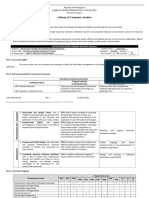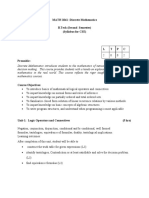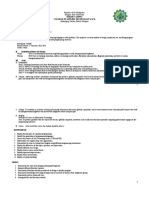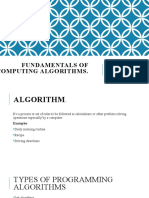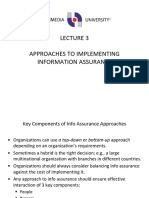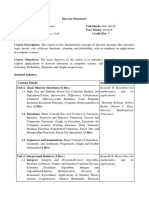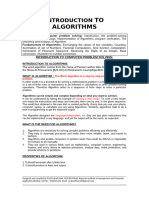Discrete Structure Syllabus
Uploaded by
Mausam PokhrelDiscrete Structure Syllabus
Uploaded by
Mausam PokhrelDiscrete Structures
Course Title: Discrete Structures Full Marks: 60 + 20 + 20
Course No: CSC160 Pass Marks: 24 + 8 + 8
Nature of the Course: Theory + Lab Credit Hrs: 3
Semester: II
Course Description: The course covers fundamental concepts of discrete structure like
introduce logic, proofs, sets, relations, functions, counting, and probability, with an emphasis on
applications in computer science.
Course Objectives: The main objective of the course is to introduce basic discrete structures,
explore applications of discrete structures in computer science, understand concepts of Counting,
Probability, Relations and Graphs respectively.
Course Contents:
Unit 1: Basic Discrete Structures (7 Hrs.)
1.1. Sets: Sets and Subsets, Power Set, Cartesian Product, Set Operations, Venn Diagram,
Inclusion-Exclusion Principle, Computer Representation of Sets
1.2. Functions: Basic Concept, Injective and Bijective Functions, Inverse and Composite
Functions, Graph of Functions, Functions for Computer Science (Ceiling Function, Floor
Function, Boolean Function, Exponential Function), Fuzzy Sets and Membership
Functions, Fuzzy Set Operations
1.3. Sequences and Summations: Basic Concept of Sequences, Geometric and Arithmetic
Progression, Single and Double Summation
Unit 2: Integers and Matrices (6 Hrs.)
2.1. Integers: Integers and Division, Primes and Greatest Common Divisor, Extended
Euclidean Algorithm, Integers and Algorithms, Applications of Number Theory (Linear
Congruencies, Chinese Remainder Theorem, Computer Arithmetic with Large Integers)
2.2. Matrices: Zero-One Matrices, Boolean Matrix Operations
Unit 3: Logic and Proof Methods (6 Hrs.)
3.1. Logic: Propositional Logic, Propositional Equivalences, Predicates and Quantifiers,
Negation of Quantified Statements, Proof of quantified statements, Nested Quantifiers,
Rules of Inferences
3.2. Proof Methods: Basic Terminologies, Proof Methods (Direct Proof, Indirect Proof, Proof
by Contradiction, Proof By Contraposition, Exhaustive Proofs and Proof by Cases),
Mistakes in Proof
Unit 4: Induction and Recursion (5 Hrs.)
4.1. Induction: mathematical Induction, Strong Induction and Well Ordering, Induction in
General
4.2. Recursive Definitions and Structural Induction, Recursive Algorithms, Proving
Correctness of Recursive Algorithms
12
Downloaded from CSIT Tutor
Unit 5: Counting and Discrete Probability (9 Hrs.)
5.1. Counting: Basics of Counting, Pigeonhole Principle, Permutations and Combinations,
Two Element Subsets, Counting Subsets of a Set, Binomial Coefficients, Generalized
Permutations and Combinations, Generating Permutations and Combinations
5.2. Discrete Probability: Introduction to Discrete Probability, Probability Theory,
Probability Calculation in Hashing, Expected Value and Variance, Randomized
Algorithms
5.3. Advanced Counting: Recurrence Relations, Solving Recurrence Relations
(Homogeneous and Non-Homogeneous equations), Introduction to Divide and Conquer
Recurrence Relations
Unit 6: Relations and Graphs (12 Hrs.)
6.1. Relations: Relations and their Properties, N-ary Relations with Applications,
Representing Relations, Closure of Relations, Equivalence Relations, Partial Ordering
6.2. Graphs: Graphs Basics, Graph Types, Graph Models, Graph Representation, Graph
Isomorphism, Connectivity in Graphs, Euler and Hamiltonian Path and Circuits,
Matching Theory, Shortest Path Algorithm (Dijkstra’s Algorithm), Travelling Salesman
Problem, Graph Coloring
6.3. Trees: Introduction and Applications, Tree Traversals, Spanning Trees, Minimum
Spanning Trees (Kruskal’s Algorithm)
6.4. Network Flows: Graph as Models of Flow of Comodities, Flows, Maximal Flows and
Minimal Cuts, The Max Flow-Min Cut Theorem
Laboratory Works:
The laboratory work consists of implementing the algorithms and concepts discussed in the class.
Student should implement problems with following concepts;
• Set Operations and Boolean Matrix Operations
• Primility Testing, Number Theory Algorithms, and Operations on Integers
• Counting and Some Recursive Algorithms
• Algorithms for Relations, Graphs
Text Books:
1. Kenneth H. Rosen, Discrete mathematics and its applications, Seventh Edition McGraw
Hill Publication, 2012.
2. Bernard Kolman, Robert Busby, Sharon C. Ross, Discrete Mathematical Structures, Sixth
Edition Pearson Publications, 2015
3. Joe L Mott, Abraham Kandel, Theodore P Baker, Discrete Mathematics for Computer
Scientists and Mathematicians, Printice Hall of India, Second Edition, 2008
Reference Books:
1. Ken Bogart, Scot Drysdale, Cliff Stein, Discrete Mathematics for Computer Scientists,
First Edition Addison-Wesley, 2010
13
Downloaded from CSIT Tutor
You might also like
- CSC 409 Algorithms and Complexity AnalysisNo ratings yetCSC 409 Algorithms and Complexity Analysis223 pages
- Syllabus Algorithms and Complexity AY 2021-2022100% (1)Syllabus Algorithms and Complexity AY 2021-20228 pages
- CS449 - Syllabus-Algorithms & ComplexityNo ratings yetCS449 - Syllabus-Algorithms & Complexity5 pages
- Principles of Programming Languages (Pe1)No ratings yetPrinciples of Programming Languages (Pe1)2 pages
- Advanced Database System Syllabus 03212021No ratings yetAdvanced Database System Syllabus 032120219 pages
- Course Outline (Data Communication and Networking 1)No ratings yetCourse Outline (Data Communication and Networking 1)3 pages
- Data Structures and Algorithms: Asymptotic NotationsNo ratings yetData Structures and Algorithms: Asymptotic Notations28 pages
- Chapter Six: Introduction To Web SecurityNo ratings yetChapter Six: Introduction To Web Security18 pages
- CS 222 - AUTOMATA THEORY AND FORMAL LANGUAGES - College-Syllabus0% (1)CS 222 - AUTOMATA THEORY AND FORMAL LANGUAGES - College-Syllabus11 pages
- Introduction To Computing (CSEN1201) Syllabus100% (1)Introduction To Computing (CSEN1201) Syllabus2 pages
- OOPJ2 - Module 1 - Introduction To Object Oriented ProgrammingNo ratings yetOOPJ2 - Module 1 - Introduction To Object Oriented Programming76 pages
- Introduction To Programming Languages and CompilationNo ratings yetIntroduction To Programming Languages and Compilation49 pages
- CS 114-Social Issues and Professional PracticeNo ratings yetCS 114-Social Issues and Professional Practice3 pages
- Ccs0003 Computer Programming 1 Lec SyllabusNo ratings yetCcs0003 Computer Programming 1 Lec Syllabus6 pages
- Topic 3 - Approaches To Implementing Information AssuranceNo ratings yetTopic 3 - Approaches To Implementing Information Assurance22 pages
- Computer Fundamentals & Programming (Exercise)No ratings yetComputer Fundamentals & Programming (Exercise)4 pages
- 01 - Software Engineering - II (Course Outline)No ratings yet01 - Software Engineering - II (Course Outline)4 pages
- C A S U P M: Course Code: CMSC 123 Course Name: Data Structures Credit: Prerequisite: Course DescriptionNo ratings yetC A S U P M: Course Code: CMSC 123 Course Name: Data Structures Credit: Prerequisite: Course Description2 pages
- CHAPTER 1 - Number Systems, Codes and ApplicationsNo ratings yetCHAPTER 1 - Number Systems, Codes and Applications19 pages
- Discrete Structures BSC - CSIT Syllabus IT College NepalNo ratings yetDiscrete Structures BSC - CSIT Syllabus IT College Nepal2 pages
- B.TECH (Computer Engineering) Semester - Iii Course SyllabusNo ratings yetB.TECH (Computer Engineering) Semester - Iii Course Syllabus17 pages
- 15B11CI212 Theoretical Foundations of Computer ScienceNo ratings yet15B11CI212 Theoretical Foundations of Computer Science2 pages
- MA203_Syllabus_Discrete Mathematics_(CSE-CSIT and Related Branches-)No ratings yetMA203_Syllabus_Discrete Mathematics_(CSE-CSIT and Related Branches-)2 pages
- B Accredited by NAAC 2009 New Syllabus For B.C.S. Part - I (Sem.-I & II) Syllabus To Be Implemented From June 2010 OnwardsNo ratings yetB Accredited by NAAC 2009 New Syllabus For B.C.S. Part - I (Sem.-I & II) Syllabus To Be Implemented From June 2010 Onwards42 pages
- CS F222 Discr Struc For Comp Sci - HandoutNo ratings yetCS F222 Discr Struc For Comp Sci - Handout3 pages
- Draft Math Ed 475 Discrete Mathematics (ICT VII)No ratings yetDraft Math Ed 475 Discrete Mathematics (ICT VII)6 pages
- Real-Time Material Balance For Flotation Plants Using A Least-Squares Recursive AlgorithmNo ratings yetReal-Time Material Balance For Flotation Plants Using A Least-Squares Recursive Algorithm14 pages
- Data Structure and Algorithms Syllabus DrafNo ratings yetData Structure and Algorithms Syllabus Draf17 pages
- Presentation-Probability in Computer &data Science Sheare For SirNo ratings yetPresentation-Probability in Computer &data Science Sheare For Sir14 pages
- Fycs Sem II Design&Analysisofalgorithm Notes.docx (1)No ratings yetFycs Sem II Design&Analysisofalgorithm Notes.docx (1)85 pages
- Power Guru - Implementing Smart Power Management On The Android PlatformNo ratings yetPower Guru - Implementing Smart Power Management On The Android Platform6 pages
- Review On Comparison Between Text Classification AlgorithmsNo ratings yetReview On Comparison Between Text Classification Algorithms4 pages
- Egyptian Journal of Petroleum: Hamid Heydari Gholanlo, Siavash Sajedi Yeganeh, Vahed Goudarzi DehriziNo ratings yetEgyptian Journal of Petroleum: Hamid Heydari Gholanlo, Siavash Sajedi Yeganeh, Vahed Goudarzi Dehrizi1 page
- Report Assignment TIS3151 (The Nanobots)No ratings yetReport Assignment TIS3151 (The Nanobots)21 pages
- Placement and Routing With Congestion Control: ECE556 Final Project Harish KrishnanNo ratings yetPlacement and Routing With Congestion Control: ECE556 Final Project Harish Krishnan9 pages
- Philippine Countryville College: Computer Studies Department Course SyllabusNo ratings yetPhilippine Countryville College: Computer Studies Department Course Syllabus7 pages
- Application Similarity Coefficient Method To Cellular ManufacturingNo ratings yetApplication Similarity Coefficient Method To Cellular Manufacturing66 pages
- Computing Patterns in Strings Bill Smyth 2024 Scribd Download100% (1)Computing Patterns in Strings Bill Smyth 2024 Scribd Download65 pages
- The Classification of Style in Fine-Art PaintingNo ratings yetThe Classification of Style in Fine-Art Painting10 pages








